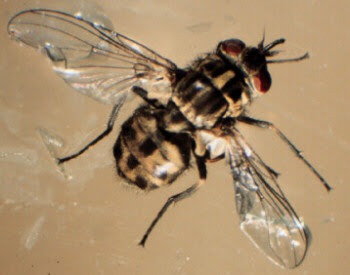- Also called as stable flies
- These are biting house flies. Bite of the fly is very painful.
- These are important vectors of many helminthes and protozoan infections.
- Specie important is S. Calcitran.
Morphology
- Size if 5.5-7.5mm and color of the fly is grey.
- Four dark, longitudinal stripes are present on the thorax.
- Mouth (proboscis) is projected forward.
- Mouth part is composed of labium, labrum and hypopharynx which carries salivary duct and delivers anticoagulant into host tissue.
Life Cycle
- Adult female lay eggs on decaying organic matter or rotting material or wheat straw, rice straw and hay contaminated by urine and feces of animals.
- Eggs are laid in batches. Each batch contains 25-50 eggs.
- Egg hatch in 1-4 days depending upon the environmental conditions.
- From the egg, larva develops. Larva maturation takes place in 6-30 days depending upon the environmental conditions. 27-29°C is the optimum temperature for larval development.
- From the larva, pupa emerges.
- From the pupa, adult emerges.
- It requires 12-60 days for completion of life cycle (egg-adult).
- Adult requires several blood meals before ovary matures and egg laying starts.
Pathogenic Effects
- Mouth parts swing downward and penetration of skin is achieved by rasping effect of teeth which lies at the end of the labium.
- It is very painful bite for animal.
- 3 minutes are required for a complete blood meal.
- Feeding is often interrupted thus allowing pathogenic organisms to enter into the body of flies and multiply there.
- Same fly when sucking blood from another animal, transmits the pathogenic organism into the other animal.
- Habronema (nematodal infection) and Trypnosomiasis (protozoan infection) are transmitted by these flies.
- Creates restlessness for the animal and human beings
- It causes production losses of 20-25 %.
- Prefer strong sunlight to live and present in abundance on building and farm.
Treatment & Control
- Provide good hygienic conditions.
- Destruction of breeding places is very much important.
- Proper drainage of the area is very important.
- Use insecticides;
Organo Chlorine…… DDT, hexachlorocyclohexane/ benzene hexachloride
Organic phosphate…. Trichlorofen, neguvan, cumafex, neocidal, diazinon and asuntal
Synthetic pyrethroid...Cypermethrine and Ecoflee
Carbamates…
- Use of flies repellant sprays such as spoton and sporon.
- Valuable animals must have ear tags, nose ring and tail bands impregnated with insecticides.
- Lower the animal movement during maximum activity of flies.


0 comments:
Post a Comment